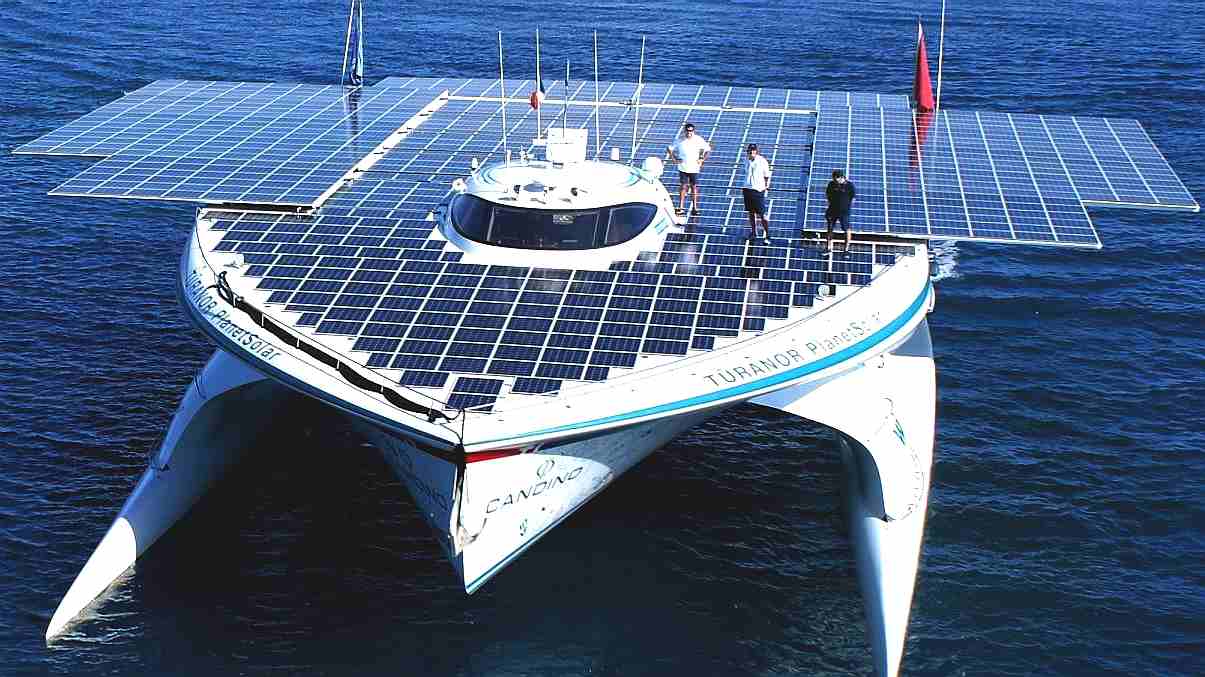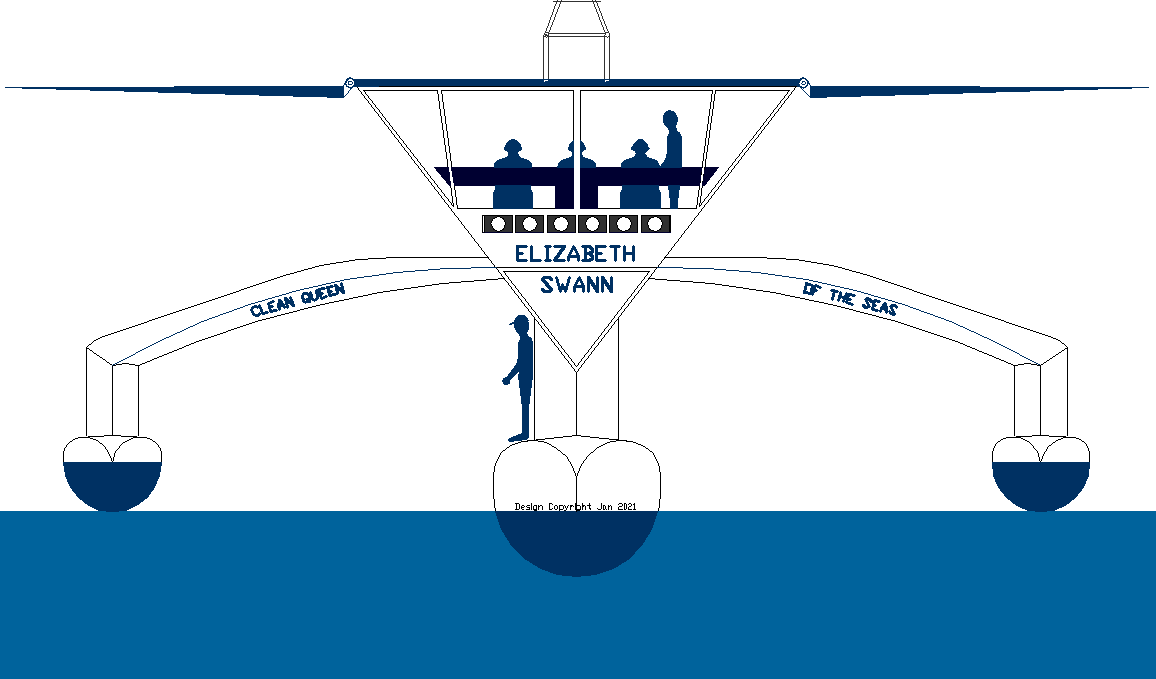
FLAT
CALM - The
Elizabeth Swann is seen here in calm conditions without hydrofoil
deployment - and it may well remain this way. The semi-circular hull presents the least wetted area as a
displacement design with ample reserve buoyancy. Being long and thin,
she needs outriggers to stabilize against roll, mainly generated by side
winds acting on the wind turbine and solar wings. Unlike high
performance sailing craft, we have the added complication of large flat
panels to contend with. The minimal frontal area of the central hull in
relation to such a large vessel, offers a big advantage in terms of reduced energy to propel the craft
and is well worth the added complexity of dual sponsons.
WP2. PLATFORM DESIGN - IMPROVING RUNNING
EFFICIENCY
As
part of WP2, we are considered the inclusion of hydrofoils in a way
that allows us to use them as stabilizers in a light roll situation. The
object being to reduce drag to just the main central hull and one
hydrofoil during suitable weather conditions. It remains to be seen if
such additional mass on the outriggers is worthwhile.
Although
smaller, lighter solar powered boats are routinely flying in competitive
events, the power to weight ratio of a heavy yacht or
commercial ship is not likely to be sufficient to lift the craft out
of the water - hence is not viable. This is especially so at low speeds,
where the size of a foil would need to be significant to provide the
required amount of lift.
One
feature of the Elizabeth Swann hull design is sponsons that are
adjustable for ride height, being active, meaning that as any roll
moment decreases, the wetted area may be reduced, and only increased on
when needed on the side opposing such forces. The other reason for using
moveable outrigger arms is to do with propulsion.
ABOUT
HYDROFOILS
Whereas,
at low speeds the hull of a ship sits in the water and fixed hydrofoils are totally submerged in the
sea, typically increasing draft.
As the boat’s speed increases, the increases in wetted area from fixed
hydrofoils create lift until above a certain speed, the lift produced by the hydrofoils equals the sum
of the boat and cargo weight - and the hull comes out of the water -
significantly reducing wetted area.
Instead of having an increase in drag with increasing speed, because the hull is lifted out of the water (contrary to what happens in traditional boats due to pressure drag), the hydrofoils provide a more efficient way of cruising.
An engineering phenomenon that limits the top speed of modern hydrofoils is
cavitation that disturbs the lift created by the foils as they move through the water at speed above 60 kn (110 km/h; 69 mph).
Fortunately, we will be operating well below such velocities.

SEMI-CIRCULAR
WING - COUNTERACTING
ROLL - At this stage we are not attempting to lift the vessel out of the
water continuously,
otherwise the ship may require a higher power to weight density than
we can provide on a uninterrupted basis using only energy from nature.
Instead we prefer a compromise where the central hull is stabilized and
the outriggers may be trimmed such that the sponson opposing wind forces
might deploy a hydrofoil with the arm raised, while the redundant
sponson may be lifted completely out of the sea.
Sailing
racing boats today, as run in the Prada Cup, America's Cup and Vendée
Globe, may be equated to the Formula 1 of ocean sports, commanding
legendary budgets to be able to match the performance of other
competitors and go faster. But why
should they have all the fun?
These
sailing boats are routinely traveling at multiples of wind speed by
reducing hull drag and only using wind power. They use arms that swing
upwards out of the water, and lower into the water on the opposing side
- and they also use robotics to operate them linked to meteorological
geo-data. This combination is closing the perceived technology gap, to
make some elements of the Elizabeth Swann concept seem quite normal.
The
big difference is that the Swann combines solar with wind power - and is
driven not by the force from sails, but by electric propulsion. The aim
being to provide predictable performance without the need for an expert
crew.
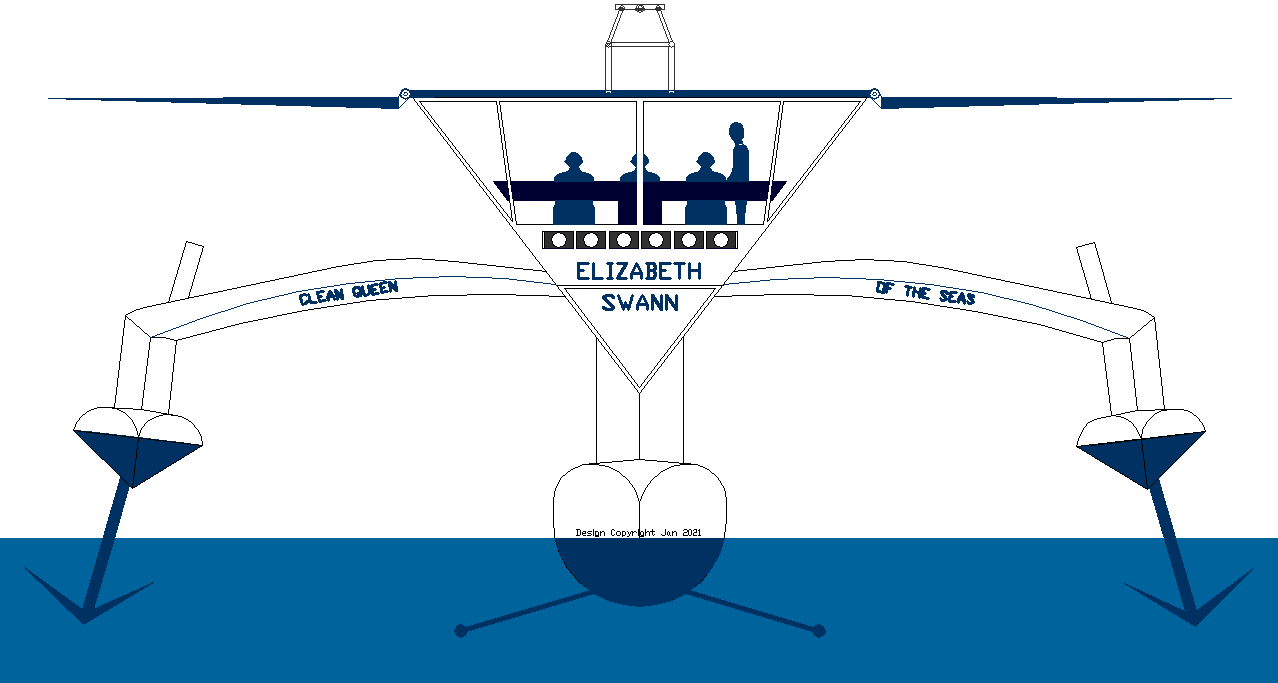
V
WINGS - CALM RUNNING - In calmer seas with a following wind and the
sun overhead, the cantilevered sponsons may be lifted out of the water,
with the V-foils. Small 4-point sailing craft benefit the most from
hydrofoils, overcoming their speed/length ratio restrictions as they
take to the air, in the process achieving wind speed.
Whereas, larger craft can reach twice wind speed for long periods, dependent
on conditions.
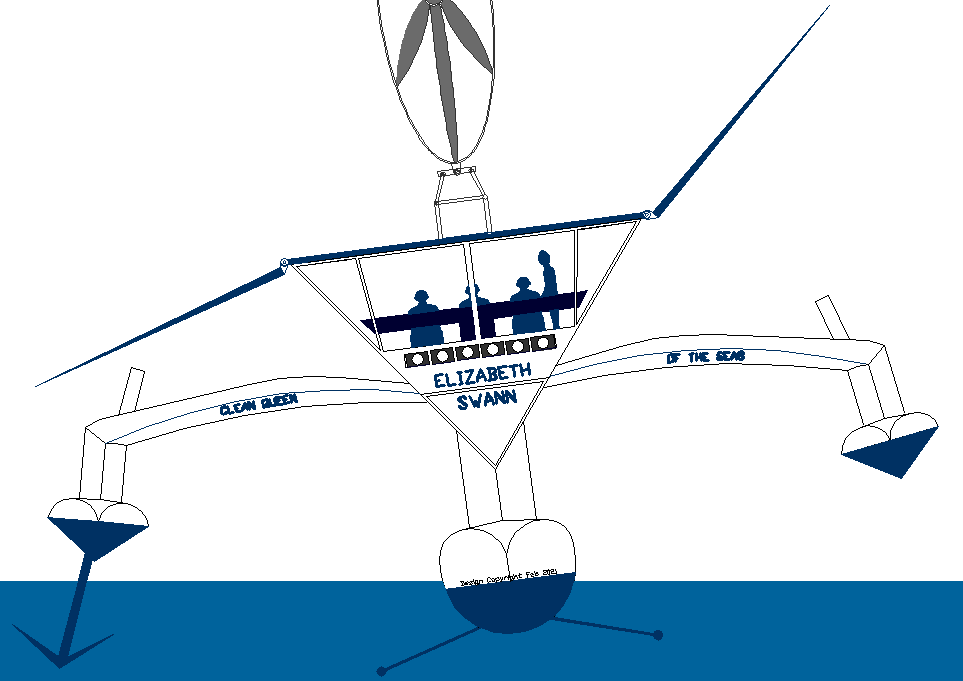
V
WINGS - COUNTERACTING
ROLL - A sailing race skipper will always take his boat to the limit
to extract every last knot, meaning large angles of roll. The same can
happen with the large surface areas on a solar boat, if the performance
parameters are set too high. The objective would be to obtain a reliable
performance, keeping the Swann as stable as possible. In other words,
avoiding high roll angles, induced by (for example) raising the port
wing to catch the sun, with wind coming from that direction operating
the turbine, adding to an angle that many cruising sailors or powered
yacht owners would find uncomfortable.
One problem that a hydrofoil craft can experience is the height of the waves being greater than the
struts - giving a whole new meaning to wave piercing hulls. Also, if the craft is traveling faster than the waves, the foils could break to the surface and
out of the water, resulting in a loss of lift and potentially a negative angle of attack when the foil dives into the next wave, making the craft crash into the
sea - thus defeating the object of the exercise. Hence, the 'V' form
compromise of the sponson and V-foil, to soften any such occurrence. A steep angle of attack is not needed in the design of
hydrofoils, indeed, small angles of attack are used to optimize the lift to drag ratio.
An
active hull like the Elizabeth Swann provides many more options in
extreme weather than traditional solar or wind powered craft.
One
of the big questions to resolve is whether to use rotary sails, or rigid
(collapsible) wing sails, like that developed by Walker Wing
Sails.
WP1. PROJECT MANAGEMENT
WP2. PLATFORM DESIGN
WP3.
PLATFORM
BUILD
WP4.
GIS, GEOSPATIAL AI INCORPORATION
WP5.
SATELLITE CYBER SECURITY, CLOUD, IoT
WP6. SHAKEDOWN TRIALS IN THE ENGLISH CHANNEL
WP7. DATA HARVESTING DURING HIGH
SPEED RUNS/RECORD ATTEMPTS
WP8.
PERFORMANCE PREDICTION FROM ASSIMILATED ANALYZED DATA
WP9. DATA DISSEMINATION
WP10. CASTING OFF & UNMANNED DOCKING
WP11.
ONBOARD/OFFBOARD VESSEL SECURITY
WP12.
AUTONOMOUS CIRCUMNAVIGATION ATTEMPT
WP13.
COLREGS
COMPLIANCE LAW & LOBBYING
2020
JULY, CRUISING WORLD - HYDROFOILS FOR SAIL BOATS
Italian Enrico Forlanini began experimenting with foils in 1898. In 1906, his 1-ton 60 hp foiler reached 42.5 mph.
Alexander Graham Bell’s HD-4 Hydrodrome flew on Bras d’ Or Lake at 70 mph in 1919. And several sailing foiler patents began appearing in the 1950s. Notably, JG Baker’s 26-foot monohull, Monitor, flew at 30-plus mph in 1955. Baker experimented with a number of foil configurations, and at least built, if not used, the first wing mast. The first offshore foiler was likely David Keiper’s flying trimaran, Williwaw, in which he crisscrossed the
Pacific in the 1960s.
Lifting foils that allow these boats to sometimes home in on three times the wind speed might appear to be of little interest to cruising sailors, but with such common cruising features as self-steering and autopilots, self-tailing winches, rope clutches, fin keels and faster hull shapes all having been passed down from the racing scene, one must ask, “What promise, if any, do hydrofoils hold?”
Modern, flying America’s Cup boats, kiteboards, Moth dinghies, shorthanded offshore thoroughbreds — are all playing in a new world in which the terms “hydrofoils” or “lifting foils” describe those oriented to raise a hull or hulls from the water. In these racing realms, if you have no foils, you are not in the race.
Numerous speed-trial and foil-enhanced offshore-racing multihulls showed huge promise, and have since evolved into behemoth trimarans clocking 30 to 40 knots continuously for long periods, not to mention the monohulls in the Vendée Globe (and soon the Ocean Race) that are capable of speeds exceeding 30
knots. But as boat designer Rodger Martin once reminded me, “If you want a new idea, look in an old book.” He was right. The fully foiling monohulls that will compete in the 2021 America’s Cup will bring things back full circle to the foiling monohull Monitor.
Any foil - a wing, sail, keel, rudder or lifting foil - redirects the flow of fluid (air included), creating high- and low-pressure areas on opposite sides of the appendage, while developing lift perpendicular to the foil’s surface.
Advancements in foiling science is due in part to the hundreds of foil shapes that were tested, with tabulated results, by the National Advisory Committee for Aeronautics, the forerunner of the National Aeronautics and Space Administration. For the better part of a century now, aircraft and boat designers have been able to choose from a spectrum of refined foil sections that produce predictable amounts of lift and drag for known speeds of fluid and angles of attack, or the angle at which the foil passes through the fluid. Sections of efficient faster foils, as seen on jets or as we flatten our sails to go upwind or reach high speeds, have smaller nose radii and are thinner, with the thickest section of the foils farther aft, up to nearly halfway toward the trailing edge.
The most efficient foil sections at slow speeds are fatter, with the maximum thickness farther forward, and with larger nose radii, than faster foils. The angle to fluid flow or angle of attack also is greater. We see these slower foils on wings of prop planes and sails when off the wind or in light conditions.
Most sailors are familiar with traditional foils on boats, the teardrop sections of keels that produce lift to weather, reducing leeway, and of rudders, allowing them to steer. Even a flat plate can be a foil, but these tend to be inefficient. Such a shape is prone to fluid separation from the surface, meaning they stall easily, and they maintain poor lift-to-drag ratios. Even keels and rudders are somewhat
lift compromised because they are symmetrical and have to work with fluid coming from either side, whereas lifting foils are more like aircraft wings or
propellers, with asymmetrical sections honed for performance in a more stable, fluid flow.
The point is, any foil can be employed at various angles to the surface to prevent leeway, produce increased stability, or help lift the boat out of the
water. But those not required to work with fluid flowing from opposite sides can then be honed to maximize lift and minimize drag. Asymmetrical foils were used on boats like Bruce King’s bilgeboarders, including Hawkeye, back in the 1970s. Designers, including Olin Stephens, had previously employed trim tabs behind keels to improve keel performance.
Sails, which are heeled airfoils, not only drive the boat forward, but they also produce downforce, actually increasing the dynamic displacement of the boat. To counter this and keep the boat sailing more upright, multihull designer Dick Newick first employed slanted asymmetrical hydrofoils in the outer hulls of his small charter
trimaran, Lark, in 1962. A portion of the lift developed by the hydrofoil resisted leeway, while a portion worked to actually lift the leeward hull, keeping the boat more upright and reducing dynamic displacement and drag.
Anyone who has ridden on even a foil-stabilized boat will know how riding at least lightly on the waves, and especially above them, beats smashing through them. When boats lift off, everything gets a lot smoother, drag falls away, and the boat accelerates.
CRUISING ON FOILS
But why would a cruiser want to whip over the sea? Wouldn’t this demand an inordinate amount of attention by the crew? Would lifting foils even be applicable to a boat that must have substantial displacement to carry crew and stores? Aren’t cruising-boat hydrofoils an oxymoron?
Maybe, but boat hulls are likely to sprout fins much as fish have as we orient foils to more efficiently resist leeway, add stability, aid steering, reduce drag, increase comfort, allow for shallower draft, and enhance wider variations in hull shapes.
Boats have gotten increasingly wide through the years to advance form stability, improve performance (primarily off the wind), and boost interior volume. But the downside is that fat boats tend to slam more upwind. What if you could reduce dynamic displacement of the boat and lift that hull even partially from the water? The result would be less slamming, especially upwind.
At the same time, what about narrower boats that are known for being more seakindly, especially when closehauled, but lack form stability to carry adequate sail area for powering upwind, and tend to roll badly downwind? Or shallow-draft vessels that are lovely for cruising, but again, tend to suffer from reduced stability? Foils can give that stability back.
Looking ahead, boat designers might choose to reduce ballast, making up for it with a foil. In short, lifting foils can reduce boat drag and motion while increasing power and performance.
Pitching also does no favors for speed or crew comfort. Foils can come into play here as well. Foils parallel to the sea’s surface resist motion up and down, and a lifted boat skating above chop also is less prone to hobby-horsing through waves. Multihulls have always been particularly susceptible to pitching for a number of reasons, but watching videos of multihulls sailing to weather show an obvious huge advantage that foilers have compared with nonfoilers. Offshore multihulls now routinely employ T-foils on the rudders to control the fore and aft angles of the
boat (attitude), a feature easily adaptable to any vessel.
OK, so what’s the cost? Obviously, the more things sticking through the hull, especially if they are retractable, the more it’s going to impact the interior. There would be added weight, complexity and cost. Foils also create noise, and there’s susceptibility to damage from hitting stuff. And let’s not forget compromises with shapes, purposes and things not yet imagined.
As for damage, it’s possible to fold the foils back into the hull. Think swinging center- boards or actual fish fins. Daggerboardlike foils can at least employ shock-absorbing systems similar to the daggerboard arrangements found in many multihulls. This includes weak links that are outside the hull, so if a foil is struck, it frees the foil to fold back or to come off before being destroyed or damaging the hull. Or, foils might hang from the deck rather than penetrating the hull, allowing them to kick up (and to be retrofitted to existing boats). These configurations also relieve the interior of intrusions, and keep the noise more removed from it. I have no doubt that numerous talented designers will be exploring all kinds of options and compromises in coming years, finding ways to make foils both practical and more than worth the compromises.
Sailing more upright, shallower draft, speed, comfort - what’s not to like?
By Steven Callahan - multihull aficionado & boat designer
2017
FINANCIAL TIMES - ON HYDROFOILS IN SAIL RACES
The arrival of hydrofoil technology in the America’s Cup, the oldest trophy in international sport, has split opinion. Some who follow the event
marveled at the technology and the dramatic change in the sport’s speed and appearance. Others were less impressed, claiming that catamarans flying above the water’s surface had little in common with most people’s understanding of sailing. Yet foiling has percolated through the sport and is engaging a new generation of sailors.
Hydrofoils are not new. In 1898, Italian inventor Enrico Forlanini obtained
patents in the UK and US for his hydrofoil designs; their basic principle raises boats out of the water using wing-like structures beneath the hull to reduce drag and increase speed.
The big budgets associated with the America’s Cup have triggered a wave of development. “Hydrofoiling isn’t new, but what has changed are the materials and control systems that now make foiling viable,” says Martin Whitmarsh, former boss of the McLaren Formula One motor-racing team and now chief executive of the Land Rover BAR America’s Cup team.
“The recent developments in America’s Cup racing are on a par with those that were developed in motorsport such as crossply tyres, fuel injection, ABS braking systems and the like. With foiling, sailing is facing a similar revolution,” he adds.
But the catalyst for the move to foils came from a much smaller boat, the International Moth. This skinny, unstable, lightweight, single-handed 3.35 metre-long dinghy embraced foiling many years ago. While it has a reputation for being tricky to sail, there has been no shortage of those wanting to give it a go. The recent world championships attracted 240 entries; many of the professional sailors came straight from the America’s Cup.
Foiling has grown quickly in other areas of dinghy racing. Boats such as Phantom International’s Flying Phantom and Nacra’s F20 have done much to attract a new generation of sailors.
UK boat builder White Formula has produced one of the first foiling catamaran dinghies aimed at club sailors, the Whisper, which is capable of more than 20 knots. “The America’s Cup is about sailing on the ragged edge, but what we wanted to produce was a foiling boat that would be user-friendly for amateur sailors,” says Rob White, founder of White Formula. The company is planning to go into full production of another foiling boat, the F101, a three-hulled trimaran, again aimed at amateur sailors.
On the professional racing scene, the Extreme Sailing Series, a touring event where 9.75m catamarans are raced close to the shore in front of spectators, has moved to foils with its new fleet. The Olympics is also turning to foils, with the Nacra 17 class set for Tokyo 2020.
Hydrofoils lend themselves better to multihulls than single-hulled boats. Multihulls are generally lighter for their size and achieve a better power-to-weight ratio, so it is easier to make foils work. But that has not stopped those in the monohull world from seeking to exploit the benefits.
The Mini Transat class of single-handed race boats designed to cross the Atlantic is leading the way. The next generation include some that will lift out of the water on their foils like multihulls. The technology has yet to be proved in a major race, but there are already other classes which are heading down a similar path. The recently launched Figaro Beneteau 3, a 30ft offshore racer, comes with retractable foils as standard.
Some teams in the recent Vendée Globe, the single-handed, nonstop around-the-world race, exploited a loophole in rules to develop semi-foiling boats. More boats with foils are expected for the next race in 2020.
While opinion might have been split over the use of hydrofoils in this year’s America’s Cup, the technology is already sweeping through the sport.
LINK
& REFERENCE
https://www.americascup.com/the-technology
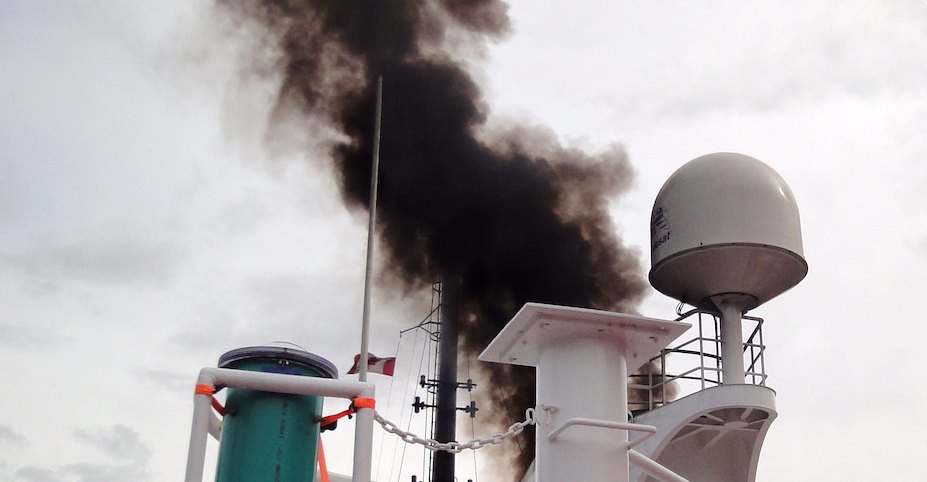
The
Cleaner Ocean Foundation works to help protect the "seven seas"
from the effects of anthropogenic atmospheric pollution like this ship
that is belching diesel fumes like there is no tomorrow. We'd like to
preserve tomorrow for our children. You can help us to make this scene a
thing of the past.
WHY
ARE WE DOING THIS?
Because
we can, and because we can, we must.
